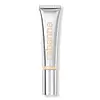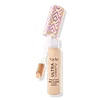What's inside
What's inside
 Key Ingredients
Key Ingredients

 Benefits
Benefits

 Concerns
Concerns

 Ingredients Side-by-side
Ingredients Side-by-side

Water
Skin ConditioningCoco-Caprylate/Caprate
EmollientPolyglyceryl-6 Polyhydroxystearate
EmulsifyingIsododecane
EmollientPolyglyceryl-6 Polyricinoleate
EmulsifyingTrimethylsiloxysilicate
EmollientMagnesium Sulfate
Disteardimonium Hectorite
StabilisingPhenoxyethanol
PreservativeGlycine Soja Oil
EmollientPotassium Sorbate
PreservativeTocopheryl Acetate
AntioxidantPolyglycerin-6
HumectantPersea Gratissima Oil
Skin ConditioningPropylene Carbonate
SolventHydrogenated Vegetable Oil
EmollientC24-28 Alkyl Methicone
EmollientParfum
MaskingPolyglyceryl-3 Diisostearate
EmulsifyingOryza Sativa Extract
AbsorbentOryza Sativa Germ Extract
EmollientXanthan Gum
EmulsifyingTocopherol
AntioxidantAscorbyl Palmitate
AntioxidantAlpha-Isomethyl Ionone
PerfumingLinalool
PerfumingCitronellol
PerfumingLimonene
PerfumingHydroxycitronellal
PerfumingHexyl Cinnamal
PerfumingGeraniol
PerfumingCI 77891
Cosmetic ColorantCI 77491
Cosmetic ColorantCI 77492
Cosmetic ColorantCI 77499
Cosmetic ColorantWater, Coco-Caprylate/Caprate, Polyglyceryl-6 Polyhydroxystearate, Isododecane, Polyglyceryl-6 Polyricinoleate, Trimethylsiloxysilicate, Magnesium Sulfate, Disteardimonium Hectorite, Phenoxyethanol, Glycine Soja Oil, Potassium Sorbate, Tocopheryl Acetate, Polyglycerin-6, Persea Gratissima Oil, Propylene Carbonate, Hydrogenated Vegetable Oil, C24-28 Alkyl Methicone, Parfum, Polyglyceryl-3 Diisostearate, Oryza Sativa Extract, Oryza Sativa Germ Extract, Xanthan Gum, Tocopherol, Ascorbyl Palmitate, Alpha-Isomethyl Ionone, Linalool, Citronellol, Limonene, Hydroxycitronellal, Hexyl Cinnamal, Geraniol, CI 77891, CI 77491, CI 77492, CI 77499
Water
Skin ConditioningCyclopentasiloxane
EmollientGlycerin
HumectantPolymethylsilsesquioxane
PEG-9 Polydimethylsiloxyethyl Dimethicone
EmulsifyingCaprylic/Capric Triglyceride
MaskingCaprylyl Methicone
Skin ConditioningC13-15 Alkane
SolventSorbitan Isostearate
EmulsifyingDimethicone
EmollientPhenyl Trimethicone
Skin ConditioningAcrylates/Stearyl Acrylate/Dimethicone Methacrylate Copolymer
Hydroxyethyl Urea
HumectantMagnesium Sulfate
Aluminum Hydroxide
EmollientIsotridecyl Isononanoate
EmollientTriethyl Citrate
MaskingCetyl PEG/PPG-10/1 Dimethicone
EmulsifyingPolypropylsilsesquioxane
Dimethicone Crosspolymer
Emulsion StabilisingQuaternium-90 Bentonite
Triethoxycaprylylsilane
Sodium Benzoate
MaskingParfum
MaskingDisteardimonium Hectorite
StabilisingPotassium Sorbate
PreservativePolyhydroxystearic Acid
EmulsifyingPropylene Carbonate
SolventEthylhexyl Palmitate
EmollientIsopropyl Myristate
EmollientIsostearic Acid
CleansingLecithin
EmollientPropanediol
SolventDisodium EDTA
Polyglyceryl-3 Polyricinoleate
EmulsifyingBenzyl Salicylate
PerfumingHexyl Cinnamal
PerfumingLimonene
PerfumingOpuntia Ficus-Indica Stem Extract
Skin ConditioningHydroxycitronellal
PerfumingGeraniol
PerfumingMaltodextrin
AbsorbentAmyl Cinnamal
PerfumingLinalool
PerfumingButylene Glycol
HumectantSodium Hyaluronate Crosspolymer
HumectantCitric Acid
BufferingSpiraea Ulmaria Extract
Astringent1,2-Hexanediol
Skin ConditioningHydrolyzed Glycosaminoglycans
HumectantSodium Hyaluronate
HumectantAloe Barbadensis Leaf Extract
EmollientButyrospermum Parkii Butter
Skin ConditioningGlycyrrhiza Glabra Root Extract
BleachingOlea Europaea Fruit Oil
MaskingPersea Gratissima Oil
Skin ConditioningSqualane
EmollientUlmus Davidiana Root Extract
Skin ConditioningMangifera Indica Seed Butter
Skin ConditioningHelianthus Annuus Seed Oil
EmollientBenzyl Glycol
SolventPanax Ginseng Root Extract
EmollientHydrolyzed Hyaluronic Acid
HumectantPentaerythrityl Tetra-Di-T-Butyl Hydroxyhydrocinnamate
AntioxidantEthylhexylglycerin
Skin ConditioningPhenoxyethanol
PreservativeHyaluronic Acid
HumectantConvallaria Majalis Bulb/Root Extract
Skin ConditioningLeontopodium Alpinum Flower/Leaf Extract
Skin ConditioningLilium Candidum Flower Extract
Skin ConditioningMagnolia Liliflora Flower Extract
Skin ConditioningPaeonia Lactiflora Root Extract
Skin ConditioningRaspberry Ketone
MaskingTocopherol
AntioxidantTbhq
AntioxidantTitanium Dioxide
Cosmetic ColorantIron Oxides
Water, Cyclopentasiloxane, Glycerin, Polymethylsilsesquioxane, PEG-9 Polydimethylsiloxyethyl Dimethicone, Caprylic/Capric Triglyceride, Caprylyl Methicone, C13-15 Alkane, Sorbitan Isostearate, Dimethicone, Phenyl Trimethicone, Acrylates/Stearyl Acrylate/Dimethicone Methacrylate Copolymer, Hydroxyethyl Urea, Magnesium Sulfate, Aluminum Hydroxide, Isotridecyl Isononanoate, Triethyl Citrate, Cetyl PEG/PPG-10/1 Dimethicone, Polypropylsilsesquioxane, Dimethicone Crosspolymer, Quaternium-90 Bentonite, Triethoxycaprylylsilane, Sodium Benzoate, Parfum, Disteardimonium Hectorite, Potassium Sorbate, Polyhydroxystearic Acid, Propylene Carbonate, Ethylhexyl Palmitate, Isopropyl Myristate, Isostearic Acid, Lecithin, Propanediol, Disodium EDTA, Polyglyceryl-3 Polyricinoleate, Benzyl Salicylate, Hexyl Cinnamal, Limonene, Opuntia Ficus-Indica Stem Extract, Hydroxycitronellal, Geraniol, Maltodextrin, Amyl Cinnamal, Linalool, Butylene Glycol, Sodium Hyaluronate Crosspolymer, Citric Acid, Spiraea Ulmaria Extract, 1,2-Hexanediol, Hydrolyzed Glycosaminoglycans, Sodium Hyaluronate, Aloe Barbadensis Leaf Extract, Butyrospermum Parkii Butter, Glycyrrhiza Glabra Root Extract, Olea Europaea Fruit Oil, Persea Gratissima Oil, Squalane, Ulmus Davidiana Root Extract, Mangifera Indica Seed Butter, Helianthus Annuus Seed Oil, Benzyl Glycol, Panax Ginseng Root Extract, Hydrolyzed Hyaluronic Acid, Pentaerythrityl Tetra-Di-T-Butyl Hydroxyhydrocinnamate, Ethylhexylglycerin, Phenoxyethanol, Hyaluronic Acid, Convallaria Majalis Bulb/Root Extract, Leontopodium Alpinum Flower/Leaf Extract, Lilium Candidum Flower Extract, Magnolia Liliflora Flower Extract, Paeonia Lactiflora Root Extract, Raspberry Ketone, Tocopherol, Tbhq, Titanium Dioxide, Iron Oxides
 Reviews
Reviews

Ingredients Explained
These ingredients are found in both products.
Ingredients higher up in an ingredient list are typically present in a larger amount.
Disteardimonium Hectorite comes from the clay mineral named hectorite. It is used to add thickness to a product.
It can also help stabilize a product by helping to disperse other ingredients.
Hectorite is a rare, white clay mineral.
Learn more about Disteardimonium HectoriteGeraniol is used to add fragrance/parfum to a product. It is the main component of citronellol. It is a monoterpenoid and an alcohol.
Monoterpenes are naturally found in many parts of different plants.
Geraniol can be found in many essential oils including Rose Oil and Citronella Oil. The scent of Geraniol is often described as "rose-like". Many foods also contain Geraniol for fruit flavoring.
Geraniol can irritate the skin when exposed to air. However, irritation depends on the ability of geraniol to penetrate into the skin. In general, geraniol is not able to penetrate skin easily.
Geraniol is colorless and has low water-solubility. However, it is soluble in common organic solvents.
Like citronellol, it is a natural insect repellent.
2,6-Octadien-1-ol, 3,7-dimethyl-, (2E)-
Learn more about GeraniolHexyl Cinnamal is a fragrance ingredient with a similar scent to jasmine. It can be naturally found in chamomile essential oil.
This ingredient is a known EU allergen and may sensitize the skin. The EU requires this ingredient to be listed separately on an ingredients list.
Hexyl Cinnamal is not water soluble but is soluble in oils.
Learn more about Hexyl CinnamalHydroxycitronellal is a fragrance created from citronellal. The smell of hydroxycitronellal is often described as "citrus-like" or "melon-like".
Hydroxycitronellal is a known EU allergen and may cause irritation when applied to the skin.
Limonene is a fragrance that adds scent and taste to a formulation.
It's found in the peel oil of citrus fruits and other plants such as lavender and eucalyptus. The scent of limonene is generally described as "sweet citrus".
Limonene acts as an antioxidant, meaning it helps neutralize free radicals.
When exposed to air, oxidized limonene may sensitize the skin. Because of this, limonene is often avoided by people with sensitive skin.
The term 'fragrance' is not regulated in many countries. In many cases, it is up to the brand to define this term. For instance, many brands choose to label themselves as "fragrance-free" because they are not using synthetic fragrances. However, their products may still contain ingredients such as essential oils that are considered a fragrance.
Learn more about LimoneneLinalool is a fragrance and helps add scent to products. It's derived from common plants such as cinnamon, mint, citrus, and lavender.
Like Limonene, this ingredient oxidizes when exposed to air. Oxidized linalool can cause allergies and skin sensitivity.
This ingredient has a scent that is floral, spicy tropical, and citrus-like.
Learn more about LinaloolMagnesium Sulfate is a salt. More specifically, it is an epsom salt, or the bath salt used to help relieve muscle aches.
Despite having ‘sulfate’ in the name, it isn’t a surfactant or cleansing agent like sodium lauryl sulfate. Unlike those sulfates, magnesium sulfate doesn’t have the same cleansing or foaming properties (it's simply a type of salt).
In cosmetics, Magnesium Sulfate is used to thicken a product or help dilute other solids. It is a non-reactive and non-irritating ingredient.
One study shows magnesium deficiency may lead to inflammation of the skin. Applying magnesium topically may help reduce inflammation.
You can find this ingredient in sea water or mineral deposits.
Learn more about Magnesium SulfateParfum is a catch-all term for an ingredient or more that is used to give a scent to products.
Also called "fragrance", this ingredient can be a blend of hundreds of chemicals or plant oils. This means every product with "fragrance" or "parfum" in the ingredients list is a different mixture.
For instance, Habanolide is a proprietary trade name for a specific aroma chemical. When used as a fragrance ingredient in cosmetics, most aroma chemicals fall under the broad labeling category of “FRAGRANCE” or “PARFUM” according to EU and US regulations.
The term 'parfum' or 'fragrance' is not regulated in many countries. In many cases, it is up to the brand to define this term.
For instance, many brands choose to label themselves as "fragrance-free" because they are not using synthetic fragrances. However, their products may still contain ingredients such as essential oils that are considered a fragrance by INCI standards.
One example is Calendula flower extract. Calendula is an essential oil that still imparts a scent or 'fragrance'.
Depending on the blend, the ingredients in the mixture can cause allergies and sensitivities on the skin. Some ingredients that are known EU allergens include linalool and citronellol.
Parfum can also be used to mask or cover an unpleasant scent.
The bottom line is: not all fragrances/parfum/ingredients are created equally. If you are worried about fragrances, we recommend taking a closer look at an ingredient. And of course, we always recommend speaking with a professional.
Learn more about ParfumPersea Gratissima Oil is also known as avocado oil.
Avocado Oil has antioxidant properties. It is mostly made up of the glycerides of fatty acids. About 67% of these fatty acids is made up of oleic acid. Palmitic acid and linoleic acid are also present.
These fatty acids help hydrate and soften the skin. It may increase collagen content in the skin. Collagen helps keep your skin plump and firm. This ingredient helps reduce inflammation and has not shown to clog pores.
This ingredient may not be fungal-acne safe due to its high fatty acid content.
Avocados also have B vitamins, vitamin K, vitamin C, vitamin E, and potassium.
Learn more about Persea Gratissima OilPhenoxyethanol is a preservative that has germicide, antimicrobial, and aromatic properties. Studies show that phenoxyethanol can prevent microbial growth. By itself, it has a scent that is similar to that of a rose.
It's often used in formulations along with Caprylyl Glycol to preserve the shelf life of products.
Potassium Sorbate is a preservative used to prevent yeast and mold in products. It is commonly found in both cosmetic and food products.
This ingredient comes from potassium salt derived from sorbic acid. Sorbic acid is a natural antibiotic and effective against fungus.
Both potassium sorbate and sorbic acid can be found in baked goods, cheeses, dried meats, dried fruit, ice cream, pickles, wine, yogurt, and more.
You'll often find this ingredient used with other preservatives.
Learn more about Potassium SorbateThis ingredient is a solvent. It helps dissolve active ingredients and alter the texture of products.
Propylene Carbonate is commonly used in makeup and with clay, such as montmorillonite or bentonite.
Studies show this ingredient to be safe for cosmetics. When it is undiluted, it can cause skin irritation. (It is always diluted in skincare and makeup). This ingredient is water-soluble.
Propylene Carbonate is created from propylene glycol and carbonic acid.
Learn more about Propylene CarbonateTocopherol (also known as Vitamin E) is a common antioxidant used to help protect the skin from free-radicals and strengthen the skin barrier. It's also fat soluble - this means our skin is great at absorbing it.
Vitamin E also helps keep your natural skin lipids healthy. Your lipid skin barrier naturally consists of lipids, ceramides, and fatty acids. Vitamin E offers extra protection for your skin’s lipid barrier, keeping your skin healthy and nourished.
Another benefit is a bit of UV protection. Vitamin E helps reduce the damage caused by UVB rays. (It should not replace your sunscreen). Combining it with Vitamin C can decrease sunburned cells and hyperpigmentation after UV exposure.
You might have noticed Vitamin E + C often paired together. This is because it is great at stabilizing Vitamin C. Using the two together helps increase the effectiveness of both ingredients.
There are often claims that Vitamin E can reduce/prevent scarring, but these claims haven't been confirmed by scientific research.
Learn more about TocopherolWater. It's the most common cosmetic ingredient of all. You'll usually see it at the top of ingredient lists, meaning that it makes up the largest part of the product.
So why is it so popular? Water most often acts as a solvent - this means that it helps dissolve other ingredients into the formulation.
You'll also recognize water as that liquid we all need to stay alive. If you see this, drink a glass of water. Stay hydrated!
Learn more about Water